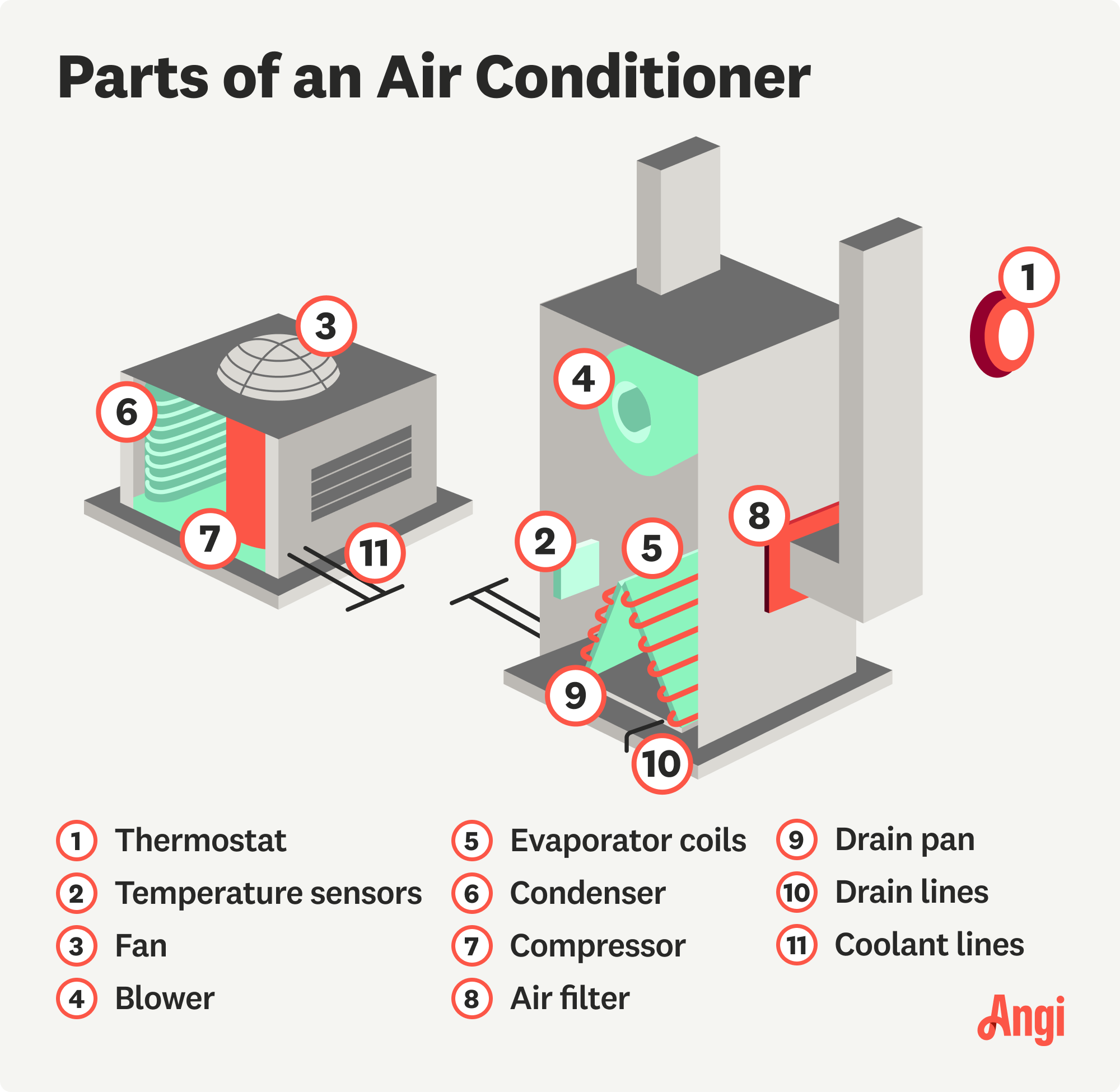
If your air conditioner won’t turn on or makes chattering noises, you might have a bad contactor. Learn more about AC contactor replacement costs in this guide.
Consider that AC drain clog hosed


Buildup and clogs in your AC drain line can wear down your AC unit and cause mold growth. Fortunately, you can clean an AC drain line with tools and household ingredients you already have, like a wet/dry vac and vinegar. Here’s how to clean an AC drain line five different ways and feel like a pro while doing it.
Complex, high-risk projects demand more than typical DIY projects. They require time, specialized tools, and trained expertise to make sure the job is done safely and correctly. We made it easy for you to find a local pro—with our skilled network, you'll get the job done without the stress of doing it yourself or significant safety risks.
An AC drain line carries captured moisture from the AC and sends it to a drip pan near your indoor unit’s evaporator coil. The water then travels through a drain line that leads outdoors. Cleaning the AC drain line removes dirt, debris, and buildup and keeps the AC unit running smoothly, preventing clogs, slowdowns, and potential mold growth.
The cost to clean an AC drain line with the help of a pro ranges from $75 to $200, depending on the issue and the cost of living in your area. But with the right tools and household supplies, you can clean the AC drain line yourself for under $5.
No matter how you clean your AC drain line, you’ll want to do a few things to prepare.

Before cleaning your AC drain line, turn off the AC at the thermostat and power off the unit at the breaker in your electrical panel. Turning the power off ensures you stay safe and eliminates the risk of electrocution.
The indoor portion of the drain line is connected to the drain pan at the bottom of your evaporator coil unit. The outdoor piece (the condensate drain line) is a 3/4-inch PVC pipe that allows water to drain out and is located near your condenser unit.
On the indoor drain line, look for a T-shaped fitting with a cap (near the air handler). Remove the cap and look inside your line. Remove any debris or blockage with gloves or a wire brush.
You can clean your AC drain line using a wet/dry vac, plunger, air compressor, or plumbing snake or by flushing it with a cleaning solution, such as vinegar or hydrogen peroxide.
A wet/dry shop vac can suck out clogs from the air conditioner drain line outside the house. Depending on what nozzles your shop vac has, you may want to purchase a drain line adapter to create a tight seal. Adapters can be found online or at local hardware stores.
Remove caps or plugs from the end of the condensate drain line outside.
Secure the shop vac hose to the end of the line and turn it on for three minutes.
Pour 1 cup of hot water or vinegar down the drain line from indoors (at the T-shaped fitting).
Suction with a wet/dry vacuum again for three minutes.
Repeat the process until the water at the end of the condensate drain line comes out clear.
Vacuum inside the indoor trap if there’s noticeable debris.
Reinstall the caps and turn the AC unit and thermostat back on.
Flushing the line might be all you need for minor clogs and mildew buildup, and the process doesn’t require any tools. A flush will kill algae, mildew, and other types of bacteria.
Do not mix vinegar with hydrogen peroxide or bleach. Mixing vinegar with hydrogen peroxide creates a toxic chemical that can irritate your skin and eyes. Combining vinegar and bleach can create a toxic chlorine gas.
With a funnel, pour 1 cup of cleaning solution down the indoor drain line. Use distilled white vinegar OR hydrogen peroxide. (But not both.) Do not use bleach, even a diluted concentration, because it can damage your pipes and your air conditioner.
Let the solution sit for 30 minutes to break up any debris, mildew, and mold.
Flush with 2 cups of hot water to remove any remaining buildup.
Look outside to see if the condensate drain line is clear and if dirty water and debris are still coming out. If they are, flush the system again.
Reinstall the cap and turn the AC unit and thermostat back on.
A plunger can help loosen a clog but can be challenging to situate on the end of the drainpipe, so consider other methods first.
Wet the base of the plunger with water.
Seal the plunger tightly over the drain line opening indoors.
Press the plunger up and down gently to dislodge clogs.
Remove any debris with a small brush or gloves.
Flush the line with 1 cup of hot water.
Look at the end of the condensate drain line outside to see if the water is clear.
Reinstall the cap and turn the AC unit back on.
If you have an air compressor, blowing air through the line can be effective, but you should use moderate pressure to prevent the pipes from cracking.
Cover the end of the drain line opening with a thin rag so that dirty water from the pipe doesn't splash back at you.
Secure the nozzle of the air compressor hose to the drain line opening. Wrap the end with electrical tape to ensure it’s tight. You may need to use an extended tip nozzle.
Turn on the air compressor to a moderate setting (30 to 60 PSI) and send air down the line to clear the clogs. Be careful: Too much forced air can damage the line.
Flush the line with hot water.
Look at the end of the condensate drain line outside to see if the water is clear.
Reinstall the cap and turn the AC unit and thermostat back on.
A plumbing snake can remove a nasty clog, but you must be familiar with the tool (and the proper size) to ensure you don’t damage the pipes.
Insert a plumbing snake or drain snake into the opening of the drain line.
Turn the snake until you feel resistance.
Keep turning the snake until you break up the clog (the rotating brush should dislodge debris).
Remove the snake from the line.
Flush the line with hot water.
Look at the end of the condensate line outdoors to see if the water is clear.
Reinstall the cap and turn the AC unit and thermostat back on.

Your AC drain line might be clogged if:
You notice condensation on your AC unit.
The drain pan is full.
The evaporator coils are frozen.
Mold is growing around your AC or in the line.
You smell a musty odor when the AC is on.
You notice water around the indoor unit.
The AC unit stops working or won’t turn on.
Because clogged AC drain lines can cause backups and mold (and even cause your AC unit to stop working), follow these tips to prevent clogs:
Clean and flush the drain line once every three months to keep it clear of debris and buildup.
Schedule an annual HVAC inspection to tune up your system and catch any issues with your condensate pan, line, or evaporator coil.
Change your air filter every three months to keep dust, debris, and pet hair out of the AC system.
Keep your outdoor unit clean and free of surrounding debris to avoid clogs and backups.
Install a condensate trap to prevent dust and debris from entering the drain line.
You can clean an AC drain line yourself without much expense. But some clogs are difficult to remove. A local AC repair pro can clear your line quickly and get your AC unit back up and running at its best. Hiring an HVAC pro costs between $75 and $200, depending on the clog and where you live.
From average costs to expert advice, get all the answers you need to get your job done.

If your air conditioner won’t turn on or makes chattering noises, you might have a bad contactor. Learn more about AC contactor replacement costs in this guide.

Average costs of HVAC inspections vary based on house size, location, and type of HVAC system. Follow our easy guide to gauge your home’s HVAC inspection cost.

If you’re having problems with your air conditioner’s condenser, it may be time for an upgrade. Learn about the cost to replace an AC condenser in this guide.

Tackling unwanted odors from indoor plants can be tricky. Learn how to use a carbon filter in your duct fan to improve air quality.

Not sure which type of furnace humidifier is best for your home? We’ve broken down four different options, explaining how they work and their benefits.
How to clean your air conditioner depends on the unit type. Sometimes, a good hose-down is all you need if you have centralized AC. This guide can help with the cleaning process.